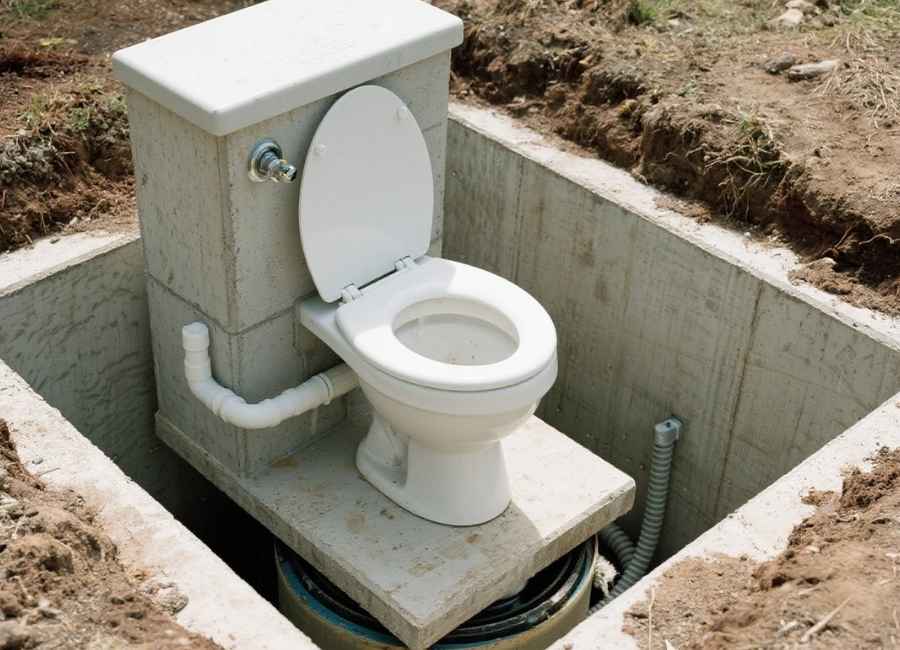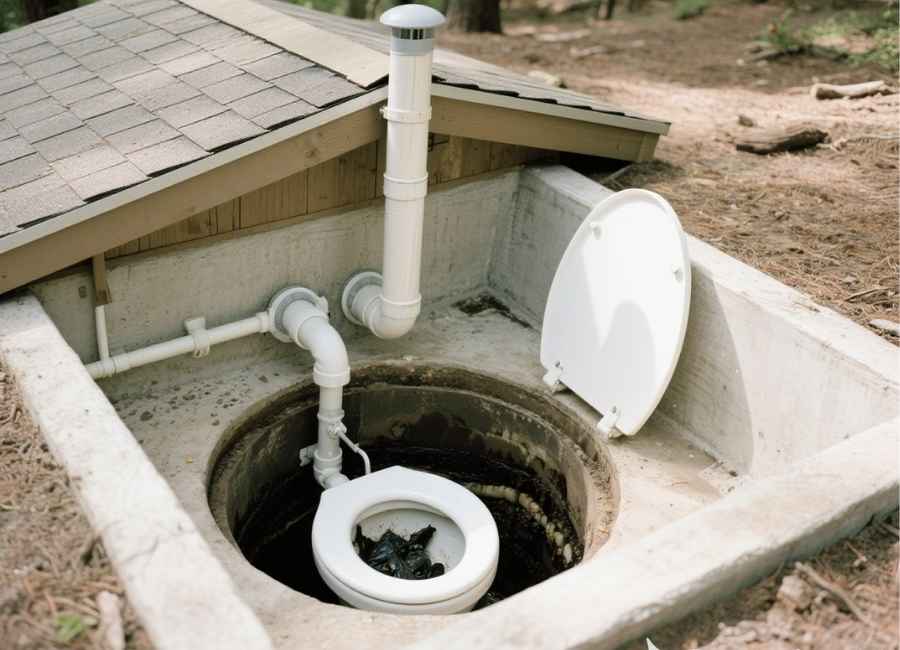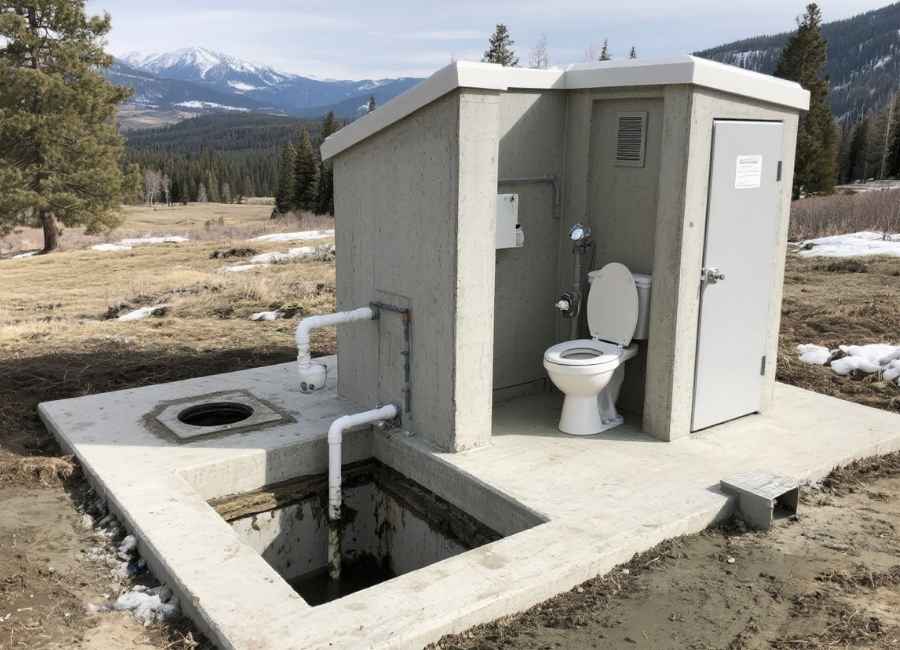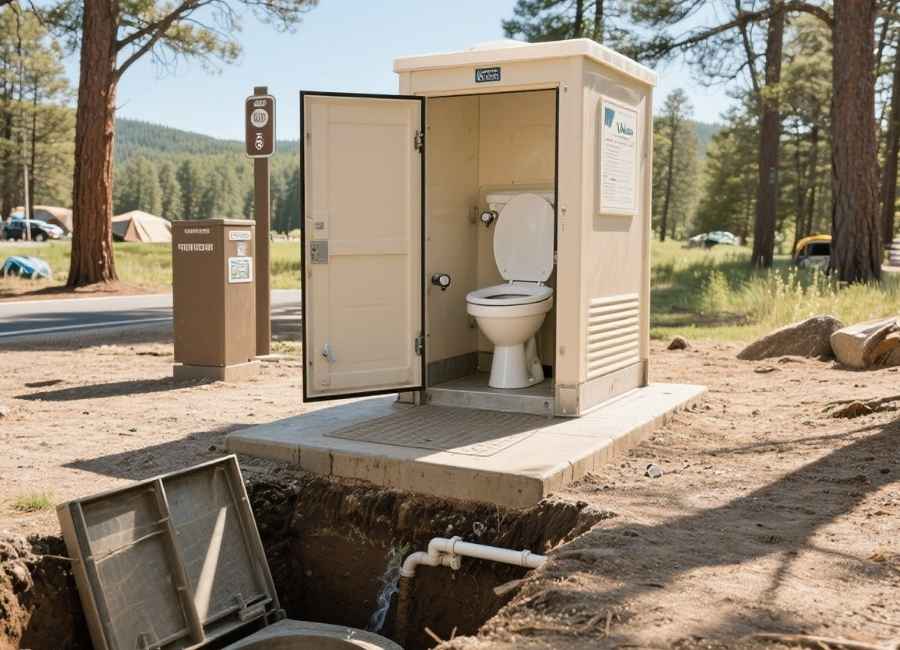If you’ve been to a national park, a remote campground, or a highway rest stop away from the city, you’ve probably used a vault toilet. These waterless toilets are standard in outdoor areas. But what really happens below ground?
Vault toilets are a practical solution for managing waste in places without regular plumbing. They are more durable and eco-friendly than pit toilets or composting systems, especially where many people visit. This guide covers how vault toilets work, their main benefits, and how they control odors.
What Is a Vault Toilet?

A vault toilet is a non-flushing toilet placed over a large, sealed underground tank called a vault. Its main job is to store waste until it can be pumped out by professionals. It works like a septic tank, but there are no water pipes going in or out.
The vault itself is typically a large, rectangular box made of reinforced concrete. The vault is usually a big, rectangular concrete box. These tanks are large so they don’t need to be pumped out often. The U.S. Forest Service says a typical vault holds 500 to 1,500 gallons of waste, so it can serve many people for a long time.a riser (a pedestal or bench) fitted with a toilet seat. Depending on the location and available resources, the shelter might have insulation or lighting. The most critical component for user comfort, however, is the ventilation system, which is designed to pull odors out of the vault and release them into the atmosphere.
How Do Vault Toilets Work?

The mechanics of a vault toilet are straightforward. Waste collects in the sealed vault, and a passive ventilation system allows gases. Vault toilets work in a simple way. Waste drops into the sealed vault, and a passive vent lets gases escape. This helps keep the shelter from smelling bad.
Ventilation: A vent pipe, usually at least three feet above the roof, is important. As the air in the vault warms up, it rises and leaves through the pipe, creating a natural draft. This brings fresh air in through the toilet riser or small vents, keeping air moving. In places with little airflow, like thick forests, a fan might be used to help.
- Location: Proper airflow around the structure is essential for dissipating odors. Ideally, the area within a 20-foot radius of the toilet should be clear of dense vegetation that could trap smells.
- Drainage: To prevent water from entering the vault, the floor of the shelter is sloped towards the door. Additionally, the maintenance hole cover used for pumping is raised slightly above the ground to keep rainwater and runoff from seeping in.
Benefits of Vault Toilets

In remote areas where installing conventional plumbing is impossible or prohibitively expensive, vault toilets offer several significant advantages.
- Environmental Protection: Because the vault is a sealed, watertight container, it prevents waste from leaching into the surrounding soil and groundwater. This represents a significant improvement over traditional pit toilets, which can pose a risk of contamination. (What Are Vault Toilets? Uses and Key Benefits Explained, n.d.)
- Durability and Low Maintenance: Made from strong materials like concrete, vault toilets can last for decades with little upkeep. (Revolutionizing Outdoor Facilities: Benefits of Missoula Concrete Construction’s Precast Concrete Vault Toilets, 2025) The main maintenance is pumping them out, which is usually done by a septic service.
- Cost-Effectiveness: Installing a vault toilet costs more at first because it needs heavy equipment, but running costs are low. (What are Vault Toilets: Benefits & Maintenance Tips, n.d.) There are no water bills, no complicated plumbing, and you don’t have to move the toilet when it’s full.
- Year-Round Operation: Because vault toilets don’t use water, there’s no risk of pipes freezing. This makes them a good choice in cold places where other systems might not work.
Are Vault Toilets Better Than Pit Toilets?
For landowners or managers of public lands, the choice For people who own or manage public land, choosing between a vault toilet and a pit toilet usually depends on how much the toilet will be used, how long it will last, and its effect on the environment.l shelter built over it. While inexpensive and straightforward to create, pit toilets have a finite lifespan. Once the pit is filled, it must be covered with soil, and the entire structure must be moved to a new location. More importantly, waste in an unlined pit can contaminate the surrounding environment, a serious concern for facilities that serve a large number of people. (In the Pits, n.d.)
A vault toilet, on the other hand, is permanent. It can be pumped out as needed, so it doesn’t have to be moved. Its sealed design protects the environment better, which is why agencies like the U.S. Forest Service prefer it for busy public lands.
Do Vault Toilets Smell Bad?
Many people wonder about this first. The answer depends on the conditions. The ventilation system is made to control smells by pulling air up and out of the shelter. On warm, sunny, and breezy days, it works very well.
However, in cold, damp, or still weather, passive ventilation may not be as effective. If the air inside the vault isn’t much warmer than outside, the draft is weaker and smells can be more pungent inside. Regular pumping and keeping the vent pipe clear are also crucial for controlling odours.
A Final Word on Off-Grid Sanitation
Vault toilets are a strong, reliable, and eco-friendly way to manage waste where regular plumbing isn’t possible. By keeping waste in a sealed underground tank, they protect the environment and offer a needed service for hikers, campers, and travelers.
Vault toilets may not have all the comforts of home, but they let us enjoy remote and beautiful places without harming the environment. Next time you see one, you’ll know how it helps keep nature clean.











